THE STORY OF
113 CRUSADER SQUADRON
AUTHORS
THE VETERANS, FRIENDS AND FAMILY
OF THE 113 SQUADRON
Foundation for the story, with additions of the site editors
was Authored by
F/O PAT G WOODWARD
~ A SQUADRON IS BORN ~
WORLD WAR I
In keeping with its odd number, 113 squadron has been involved in several unusual events during its short history, one of the oddest being at the very beginning when it was raised on 1st August 1917 as part of the Royal Flying Corps, not in the UK, but at Ismailia, Egypt, for services against the Turks 7th and 8th Armies in Palestine as part of General Allenby's army. Why the 113 number was picked is lost in history.
Corp William J Adams, 49th Balloon Section, 113 Squadron Syrass Jan 15, 1918
SOURCE: Steve Adams, Grandson. See Corp Adams profile for more information. Note that the photo states Syrass but is likely a spelling error meaning Saris. This is a village on a high hill covered with olive trees and is on the road which leads to Jaffa a few miles away.
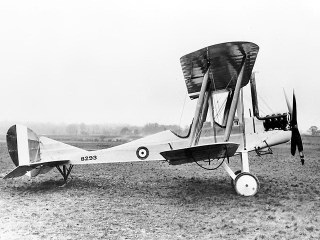 The squadron's first designation was as a `Corps Reconnaissance Unit' equipped with BE2C, BE2E, BE2E, and RE8 aircraft, and it was used operationally mainly in artillery and trench spotting. The details of this early period are sadly very sparse and at the Public Record Office there are only three pages from the Operations Record Book for
The squadron's first designation was as a `Corps Reconnaissance Unit' equipped with BE2C, BE2E, BE2E, and RE8 aircraft, and it was used operationally mainly in artillery and trench spotting. The details of this early period are sadly very sparse and at the Public Record Office there are only three pages from the Operations Record Book for BE2C Source RCAF
study. These cover the 27th and 28th October 1917 during active service at Julis when `ops' over two famous places, Beersheba and Gaza, are detailed.
Those of you who are familiar with the history of the Middle East will find the parallels between WW1 and WW2 in this theater quite extraordinary. It will at once dismay you that many of the lessons learned at great cost of life during WW1 were completely forgotten or ignored in WW2, while at the same time, it surprises time and time again that the tactics and manoeuvres so often read about in WW2 literature owes its origin to the WW1 Soldiers. Indeed you will note that some of our most famous Generals of WW2 were not in fact the author of their winning strategies as history would have us believe, rather they were the Genius of men who went before them, now largely forgotten. Anyone familiar with General Montgomery’s fame in the Western Desert in WW2 will clearly see that a very great deal of his doctrine was developed and refined in the deserts of WW1.
PALESTINE 1917
During the summer of 1917, with the Western front a stalemate turned killing field and morale sagging at home, British Prime Minister Lloyd George looked to the Middle East for a victory to boost flagging spirits at home. In Palestine the British engaged against the German backed Turks had little momentum but it was hoped that an infusion of new leadership might get things moving. Briefing Allenby in London in June 1917, Lloyd George told him that he wanted Jerusalem ‘as a Christmas present for the British nation.’ Notwithstanding the political motivations, Britan also had holdings in the Middle East to consider. Allenby arrived in Cairo on 28 June 1917 to take charge of the Egyptian Expeditionary Force replacing General Archibald Murray, his goal being to push the Turks out of Southern Palestine and the capture of Jerusalem. The ultimate defeat of Turkey, while too much to hope for at this time, was of great strategic benefit to the overall war.
Allenby’s Egyptian Expeditionary force also included an air force component which at the time was vastly inferior to the quality and quantity of the enemy German Rumpler and Fokker aircraft. Early in 1917, the air component of Allenby’s Force was allocated men and wireless sets to develop and to practise what was called ‘Artillery Co-operation’. Aerial photography was steadily developed and improved which while a valuable intelligence resource itself, was also utilized for accurate map making. Being well aware of the advantages of Air superiority, Allenby added balloon observation detachments and set up wireless detachments as an integral component of his system for directing accurate air to ground artillery fire. One of these Ballon detachments was the 49th Balloon Section of 113 Squadron of which Corp William J Adams was a part.
Aircraft Recognition chart 1914 to 1918
(Incredible how far we have come in so little time!)
Source: Charlie Walker
It was at this time that the 113 Squadron was born August 1, 1917. Among the first senior officers were Captain G G Coury, holder of a Victoria Cross and Group Captain F/Lt J H Norton. F/Lt Norton had been in Palestine since 1916 and would stay with the 113 untill it disbanded in 1918.
Another of the very first members and pilots of the newly forming 113 Squadron was 2nd-Lt Sydney Hooper who transferred in from the British West Indies Regiment to the RFC in August 1917. Another was Lieutenant William V Joslen formerly of the 3rd Battalion, The Duke Of Cornwall's Light Infantry.
Training in all areas was extensive before the attack on the Gaza-Beersheba Front. In addition to the training of aerial observers, gunners had to be trained in the use of wireless. Signallers were also transferred to the Royal Flying Corps, becoming operational before serious operations commenced in October 1917.
The frantic training of the squadron was not without incident, when on 6/10/1917 Second Lieutenant Lt Victor Sidney Smith, aged 19 was killed in a flying accident in Mesopotamia. He was the observer in a 113 Squadron BE2e.
Now with an aircraft strength of seventy-two machines, one more aircraft than the estimated enemy total, Allenby formed the Palestine Brigade, Royal Flying Corps, on the 4th of October 1917. It was comprised of two wings. The 5th (Corps) Wing of which 113 Squadron was part, was dedicated to air co-operation and direct support tasks for the surface force XXI Corps consisting of three infantry divisions under the command of Lieutenant-General Sir Edward Bulfin. The 40th (Army) Wing was dedicated to counter-air missions and operations in the rear area, such as bombing the enemy’s support infrastructure. As can be seen 113 Squadron had its roots in an army support role from the very beginning.
Towards the end of 1917, some of the squadrons began to acquire more advanced aircraft designs such as the new S.E. 5a and Bristol Fighters. An interesting use of the aircraft that reconnoitred far ahead of enemy lines was the dropping of written reports at the very feet of the troops. Although rare, transmitters were also placed in some aircraft.
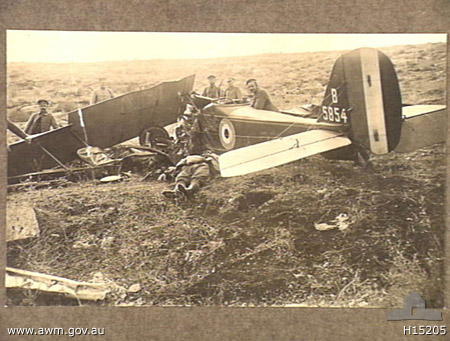
The caption to this picture on the AWM site states: QUOTE "total of ten RE8s served with No.1 Squadron, one of the ten was lost over German lines, when the aircraft of Lieutenant J.D.S. Potts and Lieutenant V.J. Parkinson, B5854 was lost in a mid-air collision with an aircraft from No.113 Squadron RAF". NOTE: According to David J Barnes citing RFC, RNAS RAF Register 1914-19, the photo is actually of 67 Squadron and he quotes; QUOTE: R.E. 8 No. B5854, Lieut J D S Potts Pilot - Killed in Action, 2nd Lieutenant V. J. Parkinson Observer / Wireless Operator - Injured and taken Prisoner of War. Australian Flying Corps 67 Squadron. Missing - Palestine 4 January 1918 (04/01/1918) Prisoner of War in German Hands Near Jenin? Left at 7.05am on a Bombing Raid to Jenin Aerodrome. In mid-air collision with Enemy Aircraft, which had attacked an R.E. 8 from 113 Squadron. Pilot killed and Observer was injured in crash 4 January 1918. (NOTE: Sharl Vicente, the grandson of Lt. Parkinson has been in contact and confirms this event and that his grandfather served with 67 Squadron, not 1 Squadron . His full name is Lt Vincent John Parkinson.)
Allenby’s opening plan was to make a carefully prepared feint toward Gaza but the real object of Allenby’s attack was Beersheba. It was in this location that water could be found in established wells and this was essential for further operations to the north. Just as it would be in the second world war, the availability of water was critical to every action, movement and operation. By mid-1917, a system had been built to pump water from the Nile and the pipeline and rail link had been extended from Cairo to the southern boundaries of Palestine. Water could be transported and distributed by motor lorries and 30,000 camels dedicated to the task, but the limit at this stage was Beersheba. A cavalry division required some 120,000 gallons a day and an infantry division 60,000 gallons.
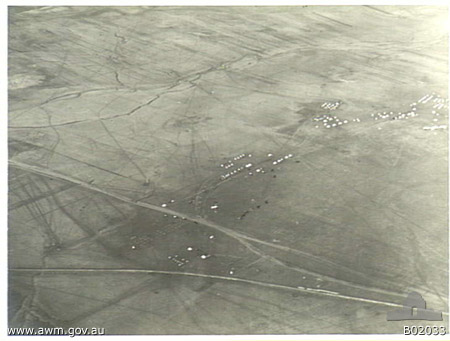
An aerial view of Julis shows in the centre the 1st Squadron of the Australian Flying Corps and on the right the 113 Squadron of the Royal Flying Corps. The line runnng across the picture in the foreground is the old gauge railroad. Note a train can be seen on the tracks. Julis was also a base during WW2
SOURCE of photo and text: WWW.awm.gov.au (Australian War Memorial)
On October 27 1917 Allenby opened his offensive against the Turkish positions at Gaza with a combined barrage of accurate gun fire from the artillery and British gun ships off the coast, all of which was being directed by airborne observers. This historic moment would have been the 113 Squadrons first taste of battle since its birth. Three days after this opening round, Allenby made his push on Bersheba and it fell virtually intact on October 31 1917. Lt William Francis Woods in a letter home wrote: very busy and very successful at taking Beersheba. Flying for 12 hours that day.
The feint had been a total success! It was not without loss to the 113 Squadron however as this same day (31/10/1917) Lieutenant J H Mueller age 21 was killed in action. Also around this time another 113 aircraft was attacked but got away when their attacker was involved in a mid-air collision with an aircraft B5854 from 67 Squadron AFC. flown by Lieutenant J.D.S. Potts and Lieutenant V.J. Parkinson.
Allenby’s mounted force then moved northward engaging the withdrawing Turkish forces which fought a series of determined rearguard actions. Simultaneously, the infantry from XXI Corps, all the while undoubtedly in communication with 113 Squadron, advanced on the Turkish positions in Gaza (their initial feint target) under a protective screen of accurate fire from the artillery and Naval gun ships. Again the push met with complete success and the Turks fled the garrison.
As the Turkish Eighth Army withdrew across the coastal plain they were cut down in great numbers by bombing and straffing. All the while the Artillery directed by the air also gave chase and when it became out of range of the retreating Turks, naval gunfire using aerial observation took over. This whole while the 113 Squadron and others were free from interference by enemy aircraft, because simultaneous air attacks were made with forty fighters and bombers against two German aerodromes and storage facilities at Iraq el Menshiye and es Tine. It is believed that only one enemy aircraft had been able to conduct air reconnaissance during the period of the battle and it had been chased and destroyed before it could report back to its base. On the 25th of November the fledgling Flying Corps requested a further twenty-five machines, up-to-date Nieuport Scouts, to be sent from France.
By the 9th of December 1917, Jerusalem belonged to Allenby and Prime Minister Loyd George had his gift for his political adversaries and the British people at home.
Allenby established his general headquarters at Bir Salem (Salim). This is a few miles south East of Jaffa and just west of Ramle (Ramleh) and together with Jerusalem further to the west, the three towns form a rough line. It is also a few miles directly north of Aqir. The main aerodrome was close at hand at Ramleh (Ramle), a place that the 113 squadron would come back to in another war that would come all too soon.
(This is reported as being on the Jaffa - Jerusalem road, about 15 kilometres from Jaffa and 50 kilometres from Jerusalem, the road being the principal artery of communication from east to west.)
THE FINAL PUSH - 1918
After Allenby’s forces had taken Jerusalem, the Palestine Brigade’s aircraft were involved in some work with the artillery and a few bombing raids were made against the enemy. The 113 Squadron at this time was operating from Sarona, a very lush pretty area just north of Jaffa and near the Auja River (now completely obliterated by Tel Aviv). It is not known how long they remained operating from here but it is believed to be quite some time. A major focus of activity was reconnaissance and photographing of the country to the north to improve maps for the comming final offensive. By the end of January 1918, over 1,000 square kilometers had been mapped by 1 Squadron. Also in January, at least one new member joined the 113 squadron, that being 2nd Lieutenant J.S. Bowker . In April Allenby made a raid to take Amman across the Jordan river but after successfully taking Es Salt it met with heavy resistance and following two other thrusts which also failed he withdrew back across the Jordan. Following this action the ground forces were largely stationary throughout the intense heat of the summer but the aerial forces kept up the pressure and gained complete air superiority. (As the British official Intelligence handbook explained in a reference to the conditions in the Jordan valley: ‘Nothing is known of the climate in summer-time, since no civilized human being has yet been found to spend summer there.’)
With improved organization, 18 new Bristol Fighters, and an aggresive spirit with hard fighting, the British had destroyed over ninety enemy aircraft. It is interesting to note that during this time 1 Squadron received a new Handley Page bomber, this undoubtedly would have been an awe inspiring sight in the desert at this time. Another interesting fact a dominion officer was unable to exercise powers of punishment over British personnel. The way around this was the granting of a supplementary commission in the Royal Air Force.
During the summer, reorganisation of the Fifth Corps Wing, of which 113 Squadron was a part, was setup as follows:
Fifth (Corps) Wing
Headquarters — Ramleh
14 Squadron, RAF — Junction Station: 16 R.E. 8’s, 3 Nieuports
113 Squadron, RAF — Sarona: 16 R.E. 8’s, 5 Nieuports
142 Squadron, RAF, (less 1 Flight) — Sarona: 7 Armstrong-Whitworths
1 Flight — Jerusalem: 5 R.E. 8’s
Roles Allocated to Squadrons for Final Battle Fifth (Corps) Wing
No. 113 Squadron was designated to cooperate with XXI Corps in the coastal sector.
No. 142 Squadron (less ‘C’ Flight) was designated to cooperate with the Desert Mounted Corps in the coastal sector. This was the cavalry force which was to use its mobility to exploit the breakthrough by XXI Corps.
No. 14 Squadron was to cooperate with XX Corps which was to advance north on the axis of the Nablus road.
‘C’ Flight, No. 142 Squadron was designated to cooperate with Chaytor’s Force in the Jordan valley. The primary role of this force was conduct diversionary tactics to lead the Turks to believe that a major attack could be expected in this sector. Chaytor’s Force also had a role to play in the protection of Allenby’s right flank.
Fortieth (Army) Wing
No. 1 Squadron, AFC, and No. 111 Squadron, RAF, No. 144 Squadron,
RAF, and 1 Flight of No. 145 Squadron, RAF, were free of direct support functions and were designated to conduct strategical reconnaissance and offensive operations.
113 Squadron was designated to the XXI Corps Infantry and was organised to assist in the passage of information. This involving signalling panels, klaxon horns, flares, disks and wireless where the fall of artillery was to be adjusted urgently, were all to be used for communication between the ground forces, aircraft and headquarters. The flexibility and innovation that were to become the hallmark of 113 Squadron and follow it through two world wars were already becomming apparent in these first days of its early life whereby they were setup to deny information to the Turkish forces by covering the advancing troops with smoke screens during the critical early phase of the initial attack. The smoke screens, which were about 400 metres long, were to be created by dropping sixty pyrotechnic devices from aircraft. The equipment for this operation had been invented by RAF personnel in the Middle East.
In all there was a total of 105 machines of all types included No. 21 Balloon Company of three sections whose company’s headquarters was at Sarona. (Also the base of 113 Squadron) The Fifth (Corps) Wing was commanded by Lieutenant-Colonel Charles Burnett, who would become the RAAF’s Chief of Air Staff during World War II.
Filling balloon hydrogen cylinders. I am certain the fellow in Flying Corps uniform far left is Corp William Adams, in which case this picture is of the 49th Balloon Section 113 Squadron.
Source unknown
Allenby’s final offensive plan eventually developed into a plan for the total destruction of the Turkish forces in Palestine. This plan was to punch through the Turkish line and exploit the mobility and speed of his cavalry in follow-through operations on the coastal plain. In this, XXI Corps assisted by 113 Squadron would break through on the coast and the cavalry would then make for the railway junction, about half-way between Tul Karm and Nablus. The XXI Corps and the XX corps cavalry would continue at speed up the Plain of Sharon to a point near Haiffa then turn inland into the Plain of Esdraelon some fifty to sixty-five kilometres behind the Turkish armies. It was a daring plan.
Three days after an Arab force under Colonel T.E. Lawrence had started operations to cut the Hejaz railway at Der’a and isolate the Turkish armies, the battle began in the early hours of September 19, 1918. In the opening round the aircraft delivered the first carefully considered blows against enemy headquarters and ‘points where telephone and telegraph exchanges were suspected’. These being determined by aerial reconnaissance that had been undertaken by 5th Corps aircraft in the early weeks of September.
Throughout the morning the Squadrons lifted off and were away to their various communication targets, and largely without interference from the enemy. This due to constant patrols by Fortieth (Army) Wing S.E. 5a’s over the main enemy aerodrome at Jenin. While the air attacks were in progress, XXI Corps launched its attack against the Turkish position on Allenby’s left flank at 4.45 a.m. Two smoke screens were laid by 113 Squadron to cover the advancing troops from view. One was successful but there were problems coordinating the other screen with the surface force, so it was laid across the frontage of one of the enemy positions. Within a short time the infantry had overwhelmed the enemy and taken their positions. Exploiting the breakthrough, the cavalry began their advance along the beach at 7.00 a.m. The very nature of such operations, where speed and manoeuvre were key features, meant that tactical decision making by junior officers and men was essential. (An edict expoused by Montomery in the war to come and obviously not of his creation)
At the outset, there was an early indication how information acquisition, a quick decision and speed of manoeuvre could bring decisive results. One of the aircraft from 113 Squadron noticed a house and an orchard a short way ahead of the leading elements of the cavalry. Flying low over the area the pilot and his observer discovered that the orchard was occupied by Turkish troops and transport. A note was written and dropped to the approaching elements of the cavalry. They put in a quick attack, taking the Turks by surprise. Sixty prisoners were captured with two guns and twelve wagons at a cost of one life and two men wounded.
Run up for takeoff. It is presumed their is another man on the starboard side holding a wing strut as well which would indicate a run up prior to takeoff. Note the unusual striped tent in background with diamond pattern. Also note the man holding the strut is wearing an old style RFC uniform. SOURCE: Michael & Peter Woods, sons of Lt William Woods
At midday, air reconnaissance revealed that the Turkish forces were retreating towards Nablus along one of the roads that had been previously photographed from the air. All available aircraft were dispatched to bomb the retreating column in a defile where it was impossible for transport to leave the road. Bristol Fighters, D.H. 9’s, and S.E. 5a’s from Richard Williams’ Fortieth (Army) Wing and a squadron from the Fifth (Corps) Wing executed the sustained attack. These aircraft were relieved every half-hour. The damage was extensive. Commander of the Turkish forces Liman von Sanders commented that the aircraft attack ‘covered the roads with dead men and horses and shattered transport’.
In the meantime, the cavalry were still advancing. Air reconnaissance early on the morning of 20 September revealed that most Turkish camps in the western sector had been burnt or abandoned. Jenin aerodrome was obviously in the process of being evacuated. There were still four aircraft on the aerodrome at El ‘Affule, but air reconnaissance aircraft could see the cavalry forces approaching rapidly. Within hours the aerodrome at El ‘Affule had been taken and from that afternoon it was used as an advanced landing ground for reconnaissance aircraft. Supplies of petrol, oil and spares were flown in to the advanced field from Ramleh and Sarona. As planned, a forward element of the cavalry force, the 13th Brigade, made a quick dash to Nazareth, arriving soon after dawn. The cavalry captured the Army-Group headquarters and documents, but only just missed taking Liman von Sanders, who made his escape in his staff car. While the rout of the Eighth Army had been taking place, Chetwode’s XX Corps had been moving northward on 19 and 20 September through difficult country attempting to engage the Seventh Turkish Army.
At first light on 21 September 1918 two Bristol Fighters from No. 1 Squadron found that the Seventh Turkish Army was retreating from Nablus through Balata and then on to Khurbet Ferweh and Ain Shibleh along the Wadi el Far’a road. On the left-hand side of the road there were steep hills and on the right-hand side of the road a sheer precipice. The Australian airmen counted about six-hundred horse-wagons and guns between Balata and Khurbet Ferweh. There were about another two-hundred horse-transports beyond Khurbet Ferweh approaching Ain Shibleh. Other long columns were moving along the Wadi el Far’a towards Ain Shibleh from the other direction. The Bristol Fighters were equipped with wireless and arrangements were made to begin concentrated bombing and strafing attacks. The attacks were organised so that two aircraft arrived over the route every three minutes and, additionally, a formation of six aircraft would attack the column of Turks every 30 minutes. In the Australian official history, Cutlack recorded that the raids continued all day. No. 1 Squadron, No. 144 Squadron, No. 111 Squadron and No. 145 Squadron — that is the squadrons of the Fortieth (Army) Wing — were the primary attacking force, but the three squadrons of the Fifth (Corps) Wing also made a contribution. Just over 9 tons of bombs were dropped and 56,000 rounds of machine-gun ammunition were fired into the troops below. The Wadi el Far’a soon became choked and the attacks turned into a sickening slaughter which deeply affected the airmen. Few Turks returned fire and only two aircraft were downed with the loss of their occupants. Cutlack observed that: ‘In all the history of war there can be few more striking records of wholesale destruction.’
By the evening of 21 September, the Seventh Turkish Army and the Eighth Turkish Army were ineffective fighting forces.
On 22 September 1918, the Turkish Fourth Army who had been unaware of the destruction of the 7th and 8th armies awoke and began withdrawing with Chaytor’s Force on their heels. Thriughout the Fourth Army retreat 1 Squadron aircraft harrassed them. On the afternoon of the 24th Chaytor’s Force captured Amman. They occupied this position to intercept the Turkish Second Corps which was withdrawing from the south; it surrendered without fighting. Minor operations to clean up groups of retreating Turks continued for a few days. At the end of that time Chaytor’s Force had taken 10,322 prisoners, 57 guns, 132 machine-guns, together with stores and railway rolling stock.
Allenby had taken Palestine by 26 September 1918. Two Turkish armies — the Seventh and the Eighth — had been annihilated and the remnants of the Fourth Turkish Army were in retreat. Some 50,000 prisoners had been taken. It had been the most spectacular campaign of the war.
we have one other tangible reminder of those early days which is the squadron badge,  as shown left, depicting the five Crusader crosses and crossed swords commemorating the squadron's role in the defence of Holy Land. At the end of hostilities in 1918 the squadron returned to Egypt and although not formally disbanded ceased to exist on 1st February 1920 when it was renumbered as 208 squadron.
as shown left, depicting the five Crusader crosses and crossed swords commemorating the squadron's role in the defence of Holy Land. At the end of hostilities in 1918 the squadron returned to Egypt and although not formally disbanded ceased to exist on 1st February 1920 when it was renumbered as 208 squadron.
NOTE: The squadron never served on the Western Front in France which means that those who still possess a copy of the programme of the `Farewell Dinner' at Zayatkwin on 4th October 1945 will need to amend the first paragraph on page 2.
SOURCE NOTE: The foundation for the Squadrons WW1 history is a heavily edited version of "General Sir Edmund Allenby’s Joint Operations in Palestine, 1917-18" Authored by Dr John Leonard Mordike as published by the Aerospace Centre. PAPER NUMBER 6 ISBN 0 642 26575 5 COPYRIGHT COMMONWEALTH OF AUSTRALIA August 2002. The full text of this wonderfully well written history can be read at:
www.raaf.gov.au/airpower/publications/papers/apdc/APDC06_Joint_Operations_in_Palestine.pdf
NOTES:
-SAF, School of Aerial Fighting
-There were two main Flying Instructors School's (FIS) initally, the first several miles south of Heliopolis Egypt and another at El Khanka.
-Mena house is located near the giant Pyramids.
-Shepherd's Hotel in Cairo was a popular meeting place for Officers and "out of bounds" for other ranks. The Hotel was also used during WW2 as a rest house.
-The Royal Flying Corps was absorbed into the Royal Air Force and subsequently new uniforms were adopted. This fact helps in dating photos but due to shortage there was a phase in period. These replaced the double-breasted coats, Sam Browne belts, riding breeches and field boots. The new uniforms were single-breasted jackets having a cloth belt of same material sewn on. Long slacks replaced the riding breeches and field boots. Rank was shown by braids on the shoulder epaulettes and could be removed. The cap had the R.A.F. crown emblem flanked by "gold" bars on each side with the number denoting rank.
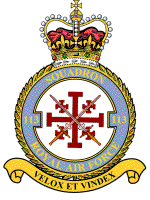

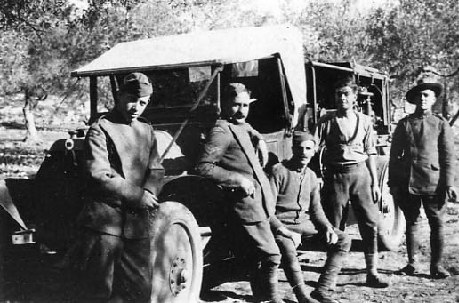
 The squadron's first designation was as a `Corps Reconnaissance Unit' equipped with BE2C, BE2E, BE2E, and RE8 aircraft, and it was used operationally mainly in artillery and trench spotting. The details of this early period are sadly very sparse and at the Public Record Office there are only three pages from the Operations Record Book for
The squadron's first designation was as a `Corps Reconnaissance Unit' equipped with BE2C, BE2E, BE2E, and RE8 aircraft, and it was used operationally mainly in artillery and trench spotting. The details of this early period are sadly very sparse and at the Public Record Office there are only three pages from the Operations Record Book for 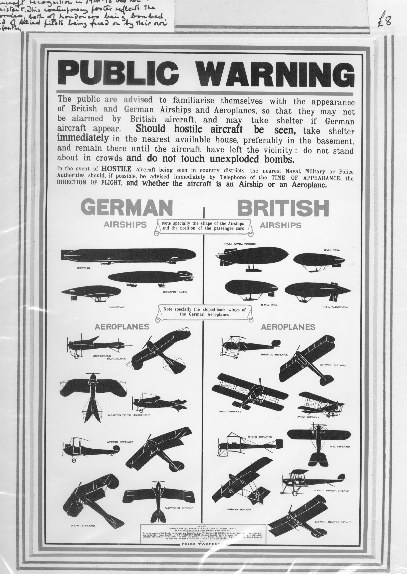




 as shown left, depicting the five Crusader crosses and crossed swords commemorating the squadron's role in the defence of Holy Land. At the end of hostilities in 1918 the squadron returned to Egypt and although not formally disbanded ceased to exist on 1st February 1920 when it was renumbered as 208 squadron.
as shown left, depicting the five Crusader crosses and crossed swords commemorating the squadron's role in the defence of Holy Land. At the end of hostilities in 1918 the squadron returned to Egypt and although not formally disbanded ceased to exist on 1st February 1920 when it was renumbered as 208 squadron.